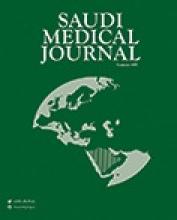REVIEW ARTICLE
The role of microRNAs in regulating myocardial ischemia reperfusion injury
This review by Fan and Yang summarizes the latest insights on the role of specific microRNAs (miRNAs) in myocardial ischemia reperfusion (I/R) injury, and the data indicates that the roles of different miRNAs are much different in this process. Briefly, miRNAs including miRNA-126, miRNA-133, miRNA-144, miRNA-145, miRNA-199a, miRNA-210, miRNA-214, miRNA-494, miRNA-451, miRNA-499 are protective after myocardial I/R injury. While the miRNAs including miRNA-1, miRNA-15, miRNA-92a, miRNA-320 have opposite effects. Complexly, some other miRNAs such as miRNA-21, miRNA-24, miRNA-29 have a double-edged role. Modulation of miRNA levels directly, or indirectly provides a therapeutic advantage to interfere with myocardial I/R injury.
see page 787
ORIGINAL ARTICLES
Prevalence of human immunodeficiency virus, hepatitis C virus, and hepatitis B virus infection among heroin injectors in the central region of Saudi Arabia
The hepatitis B virus (HBV), hepatitis C virus (HCV), and human immunodeficiency virus (HIV) infections is still very common among heroin injectors in Saudi Arabia, just like in Western countries. Alshomrani carried out a retrospective data analysis of all heroin addicts admitted to the Alamal Complex for Mental Health in Riyadh, Saudi Arabia between 2006 and 2012. His study showed a prevalence of 77.8% for HCV, 7.7% for HBV, and 9.8% for HIV infection. In comparison with actual prevalence of these infections among the general Saudi population, this high prevalence indicates a major public health concern. Infection control strategies such as, harm reduction, opioid substitution therapy, patients and staff education, and providing infection treatment services at such centers should be reconsidered.
Frequency of hepatitis B virus (HBV), hepatitis C virus (HCV), and human immunodeficiency virus (HIV) infections among 378 Saudi heroin users by different age group
see page 802
Completeness of adverse drug reactions reports of the Saudi adverse event reporting system
The adverse drug reactions reporting information in the Saudi Adverse Event Reporting System (SAERS) needs to be assessed to evaluate the completeness and quality of the information. In this study, Alshammari et al start assessing the SAERS database, which is part of the Saudi Food and Drug authority vigilance system as post marketing surveillance. Reports received between December 2009 and June 2012 were all included in the SAERS for the purpose of this evaluation. As the main finding, the SAERS is relatively considered a new system, despite that; it has a high number of reports. However, there is a need to improve the completeness of some important fields to help in discovering new signals.
The total report section completeness percentages of the information detailed in reporting forms during the study period. ADR - adverse drug reactions
see page 821
Chronic renal failure in a patient with bilateral ureterocele
Chronic renal failure is a rare complication of bilateral ureterocele. Early detection of the abnormalities and adequate treatment may prevent development of irreversible renal failure. Dada et al report a case of a young Nigerian girl with bilateral ureterocele who presented with chronic renal failure that required renal replacement therapy, and features of type III pseudohypoaldosteronism. Her management was inadequate due to financial and resource constraints. The case underscores the need for proper evaluation and follow-up of patients with childhood clinical features of ureterocele to prevent future complications. It also illustrated the financial burden of patients with chronic renal failure in Africa.
Ultrasound showing: A) dilated cystic distal portion of the ureters; and B) opening into the urinary bladder. Arrowheads indicating ureteroceles
see page 862
- Copyright: © Saudi Medical Journal
This is an open-access article distributed under the terms of the Creative Commons Attribution-Noncommercial-Share Alike 3.0 Unported, which permits unrestricted use, distribution, and reproduction in any medium, provided the original work is properly cited.









